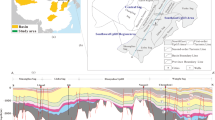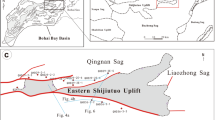Abstract
The Fushan Depression is a hydrocarbon-bearing half-graben rift sub-basin located in the southeast of the Beibuwan Basin, South China Sea. The sublacustrine fan systems in the Paleogene Liushagang Formation have recently become important targets in this depression, while the depositional process and detailed characterization of these systems are little known. Analysis of drilled cores, wire-line logs, and 3-D seismic survey suggest that the Fushan Depression develops two different types of sublacustrine fan systems. The fine-grained sublacustrine fan system located in the western area is mainly composed of fine- to medium-grained light gray sandstones interbedded with layers of silt-rich shales. This kind of sediment slumped from the distal bar of the delta front due to high sediment pore pressures at the slope edge as well as the activity of the Meitai Fault. By contrast, the coarse-grained sublacustrine fan system formed in the eastern area is characterized by medium to coarse gray sandstones and conglomerates with the development of various deformed lenticular beddings, deformed pillow structures, and micro-faults. Further study suggests that its sedimentation process is closely related to the geomorphology of flexure slope-break belt. The slope changed abruptly from 3°~5° to 7°~9° across the flexure slope point, increasing the accommodation space under the flexure belt. The coarse-grained sublacustrine fan formed when coarse-grained sediment spillover the slope-break toward the increased accommodation space. As the reservoir quality of these sublacustrine fan systems is well controlled by the sedimentary characteristics and sedimentation processes, our results should be of great significance for the development of future exploration.









Similar content being viewed by others

References
Bellaiche G, Droz L, Gaullier V, Pautot G (1994) Small submarine fans on the eastern margin of Corsica: sedimentary significance and tectonic implications. Mar Geol 117:177–185. doi:10.1016/0025-3227(94)90013-2
Benvenuti M (2003) Facies analysis and tectonic significance of lacustrine fan-deltaic successions in the Pliocene-Pleistocene Mugello Basin, Central Italy. Sediment Geol 157:197–234. doi:10.1016/s0037-0738(02)00234-8
Bouma AH (2000) Fine-grained, mud-rich turbidite systems: model and comparison with coarse-grained, sand-rich systems. Special Publication-SEPM 68:9–20
Bouma AH, Normark WR, Barnes NE (1985) COMFAN: needs and initial results. In: Bouma AH, Normark WR, Barnes NE (eds) Submarine fans and related turbidite systems. Frontiers in sedimentary geology. Springer, New York, pp. 7–11. doi:10.1007/978-1-4612-5114-9_2
Carroll AR, Bohacs KM (1999) Stratigraphic classification of ancient lakes: balancing tectonic and climatic controls. Geology 27:99–102
Catuneanu O (2006) Principles of sequence stratigraphy. Elsevier
Chen D, Pang X, Jiang Z, Zeng J, Qiu N, Li M (2009) Reservoir characteristics and their effects on hydrocarbon accumulation in lacustrine turbidites in the Jiyang Super-depression, Bohai Bay Basin, China. Mar Pet Geol 26:149–162. doi:10.1016/j.marpetgeo.2008.03.003
Chen G, Wang T, Li L, Li S, Li J (2010) Characteristics of sublacustrine fan in half-graben rift lake basin and its petroleum prospecting: case study on the second member of Tenggeer Formation, Saihantala Sag, Erlian Basin. Petrol Explor Dev 37:63–69
Chen S, Gan H, Shi Y, Zhao Y, Wang X (2015) Geochemical features and geologic significance of source rocks in Fushan Sag, Beibuwan Basin. Petroleum Geology and Recovery Efficiency 22:14–25 (in Chinese with English abstract) doi:10.13673/j.cnki.cn37-1359/te.2015.01.003
Damuth JE, Kumar N (1975) Amazon cone: morphology, sediments, age, and growth pattern. Geol Soc Am Bull 86:863–878
Dasgupta P (2002) Architecture and facies pattern of a sublacustrine fan, Jharia Basin, India. Sediment Geol 148:373–387. doi:10.1016/s0037-0738(01)00141-5
Feng Z et al. (2010) Lacustrine turbidite channels and fans in the Mesozoic Songliao Basin, China. Basin Res 22:96–107
Gong ZS (1997) The major oil and gas fields of China offshore. Petroleum Industry Press, Beijing
Jin SD, Wang H, Cao HY, Chen S, Lin ZL, JH Y, Pan SQ (2014) Sedimentation of the Paleogene Liushagang Formation and the response to regional tectonics in the Fushan Sag, Beibuwan Basin, South China Sea. Austrian J Earth Sci 107:112–130
Leeder MR, Collier REL, Aziz LHA, Trout M, Ferentinos G, Papatheodorou G, Lyberis E (2002) Tectono-sedimentary processes along an active marine/lacustrine half-graben margin: Alkyonides Gulf, E. Gulf of Corinth, Greece. Basin Res 14:25–41. doi:10.1046/j.1365-2117.2002.00164.x
Li M, Wang T (2015) The progress and application of reservoir geochemistry in hydrocarbon exploration:an example from the Fushan Depression, Beibuwan Basin, South China Sea. Earth Science Frontiers 22:215–222 in Chinese with English abstract
Li M, Wang T, Liu J, Zhang M, Lu H, Ma Q, Gao L (2007) A discussion on hydrocarbon accumulation dating determined by homogenizaton temperature and burial history of fluid inclusions. Oil Gas Geol 28:151–158 in Chinese with English abstract
Li M, Wang T, Liu J, Zhang M, Lu H, Ma Q, Gao L (2008a) The occurrence of oleananes in the Beibuwan Basin and its application to the study of maturity and oil-source rock correlation. Acta Geologica Sinica-English Edition 82:585–595
Li M, Wang T, Liu J, Zhang M, Lu H, Ma Q, Gao L (2008b) Total alkyl dibenzothiophenes content tracing the filling pathway of condensate reservoir in the Fushan Depression, South China Sea Science in China Series D: Earth. Sciences 51:138–145
Li MJ, Wang TG, Liu J, Lu H, WQ W, Gao LH (2008c) Occurrence and origin of carbon dioxide in the Fushan Depression, Beibuwan Basin, South China Sea. Mar Pet Geol 25:500–513. doi:10.1016/j.marpetgeo.2007.07.007
Li Y, Wang H, Liu E, Liao Y, Lin Z, Ma Q (2014) Distribution regularities and control factors for reservoir formation within sequence stratigraphic framework in Fushan Sag, Beibuwan Basin. Journal of Central South University (Science and Technology) 45:1542–1554 in Chinese with English abstract
Lin Z, Wang H, Li H, Ma Q, Li Y, Zhao S (2015) Genetic mechanism of double-layer structure in Paleogene of Fushan Sag, Beibu Gulf Basin. Earth Science-Journal of China University of Geosciences 40:169–178 . doi:10.3799/dqkx.2015.012in Chinese with English abstract
Liu L, Mo S, Tong Y (2003a) A discussion on the Paleogene sublacustrine fan of Fushan depression in Beibuwan Basin, northern South China Sea. Acta Petrol Mineral 22:138–142 in Chinese with English abstract
Liu L, Tong Y, Ji Y, Kuang H, Lu M (2003b) Sedimentary characteristics and developing background of the sublacustrine fan in the Liushagang Formation of the Fushan Depression, Beibuwan Basin. Petroleum Geology and Experiment 25:110–115 in Chinese with English abstract
Liu E, Wang H, Lin Z, Li Y, Ma Q (2012) Characteristics and hydrocarbon enrichment rules of transfer zone in Fushan Sag, Beibuwan Basin. Journal of Central South University (Science and Technology) 43:3948–3953 in Chinese with English abstract
Liu E, Wang H, Li Y, Zhou W, Leonard ND, Lin Z, Ma Q (2014) Sedimentary characteristics and tectonic setting of sublacustrine fans in a half-graben rift depression, Beibuwan Basin, South China Sea. Mar Pet Geol 52:9–21. doi:10.1016/j.marpetgeo.2014.01.008
Liu E, Wang H, Li Y, Leonard ND, Feng Y, Pan S, Xia C (2015) Relative role of accommodation zones in controlling stratal architectural variability and facies distribution: insights from the Fushan Depression, South China Sea. Mar Pet Geol 68:219–239. doi:10.1016/j.marpetgeo.2015.08.027
Luo Q, Pang X (2008) Reservoir controlling mechanism and petroleum accumulation model for consequent fault and antithetic fault in Fushan Depression of Hainan area. Acta Pet Sin 29:363–367 in Chinese with English abstract
Ma Q, Zhao S, Liao Y, Lin Z (2012) Sequence architectures of Paleogene Liushagang Formation and its significance in Fushan Sag of the Beibuwan Basin. Earth Science-Journal of China University of Geosciences 37:667–678 in Chinese with English abstract
Martin R (1966) Paleogeomorphology and its application to exploration for oil and gas (with examples from western Canada. AAPG Bull 50:2277–2311
Mata SA, Bottjer DJ (2013) Facies control on lower Cambrian wrinkle structure development and paleoenvironmental distribution, southern Great Basin, United States. Facies 59:631–651. doi:10.1007/s10347-012-0331-3
Mattern F (2005) Ancient sand-rich submarine fans: depositional systems, models, identification, and analysis. Earth Sci Rev 70:167–202
Moore G, Starke G, Bonham L, Woodbury H (1978) Mississippi Fan, Gulf of Mexico-physiography, stratigraphy, and sedimentation patterns framework, facies, and oil-trapping characteristics of the Upper Continental. Margin 7:155–191
Mutti E, Ricci Lucchi F (1972) Sediments and growth pattern of Navy deep-sea fan, San Clemente Basin, California Borderland:. Jour Geology 80:198–223
Nelson CH, Karabanov EB, Colman SM, Escutia C (1999) Tectonic and sediment supply control of deep rift lake turbidite systems: Lake Baikal, Russia. Geology 27:163–166
Normark WR (1970) Growth patterns of deep-sea fans. AAPG Bull 54:2170–2195
Qiu ZJ, Gong ZS (1999) Oil exporation in China: offshore. Geological Press and Petroleum Industry Press, Beijing in Chinese
Rajchl M, Ulicny D, Mach K (2008) Interplay between tectonics and compaction in a rift-margin, lacustrine delta system: Miocene of the Eger Graben, Czech Republic. Sedimentology 55:1419–1447. doi:10.1111/j.1365-3091.2008.00951.x
Richards M, Bowman M, Reading H (1998) Submarine-fan systems I: characterization and stratigraphic prediction. Mar Pet Geol 15:689–717
Shanmugam G, Moiola R (1988) Submarine fans: characteristics, models, classification, and reservoir potential. Earth Sci Rev 24:383–428
Shi Y, Liu J, Zhang M, Chen D, Ma Q (2007) Experience and understand in oil and gas exploration in Fushan Sag. Hainan Province South China Journal of Seismology 27:57–68 in Chinese with English abstract
Sotak J, Pereszlenyi M, Marschalko R, Milicka J, Starek D (2001) Sedimentology and hydrocarbon habitat of the submarine-fan deposits of the Central Carpathian Paleogene Basin (NE Slovakia. Mar Pet Geol 18:87–114. doi:10.1016/s0264-8172(00)00047-7
Stelting CE, Bouma AH, Stone CG (2000) Fine-grained turbidite systems: overview. In: Bouma AH, Stone CG (eds) AAPG Memoir 72/SEPM Special Publication No. 68. American Association of Petroleum Geologists
Vail PR, Posamentier HW (1988) Principles of sequence stratigraphy. In: Sequences, stratigraphy, sedimentology: surface and subsurface, vol Memoir 15. CSPG Special Publications
Vail PR, Mitchum Jr RM, Thompson III S (1977) Seismic stratigraphy and global changes of sea level. In: Seismic stratigraphy—applications to hydrocarbon exploration, vol Memoir 26. AAPG Special Volumes, pp 49–212
Wang G, Huang C, Liu E, Li Y, Pan S (2014) Characteristics of slope-breaks and its control on sedimentation and hydrocarbon accumulation of Liushagang Formation in gentle slope of South Fushan Sag. Journal of Central South University (Science and Technology) 45:1531–1541 in Chinese with English abstract
Weimer P, Link MH (1991) Seismic facies and sedimentary processes of submarine fans and turbidite systems. Springer
Zhang J, He J, Gong X, Zhang X, Huang W (2012) Petroleum system, oil and gas migration and accumulation in Fushan Depression, Beibuwan Basin of South China Sea. Marine Geology Frontiers 28:30–37 in Chinese with English abstract
Zou CN et al. (2013) Continuous hydrocarbon accumulation over a large area as a distinguishing characteristic of unconventional petroleum: the Ordos Basin, North-Central China. Earth Sci Rev 126:358–369. doi:10.1016/j.earscirev.2013.08.006
Acknowledgment
We would like to express our appreciation to the Associate Editor Dr. Beatriz Bádenas and two anonymous reviewers for their comments and suggestions, as well as the Editor-in-Chief Dr. Abdullah M. Al-Amri for his help and advice. We appreciate the Typesetting Editor as well for the improvement of the wording and syntax of this article. Our thanks are also extended to the Fushan Oilfield Company of PetroChina for support in material collecting and permission to publish. This study is financially supported by the program of the National Natural Science Foundation of China (Grant No. 41472084). The China Scholarship Council (CSC) is acknowledged as well for financing the first author studying at GFZ German Research Centre for Geosciences.
Author information
Authors and Affiliations
Corresponding authors
Rights and permissions
About this article
Cite this article
Pan, S., Wang, H., Yang, Z. et al. Fine-grained and coarse-grained Paleogene sublacustrine fan systems in Fushan Depression, Beibuwan Basin, South China Sea: implications for sedimentary characteristics and depositional processes. Arab J Geosci 9, 642 (2016). https://doi.org/10.1007/s12517-016-2674-5
Received:
Accepted:
Published:
DOI: https://doi.org/10.1007/s12517-016-2674-5



